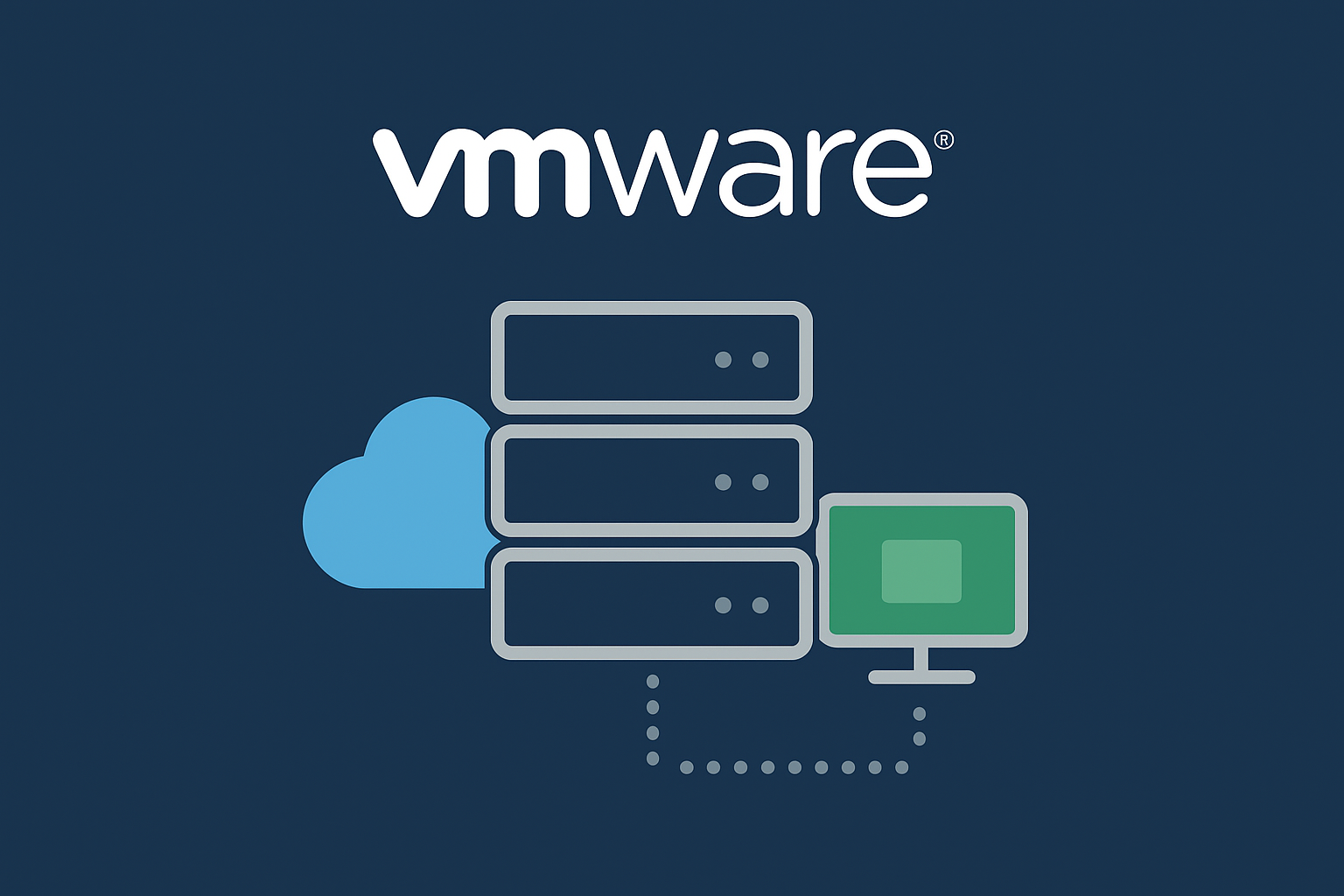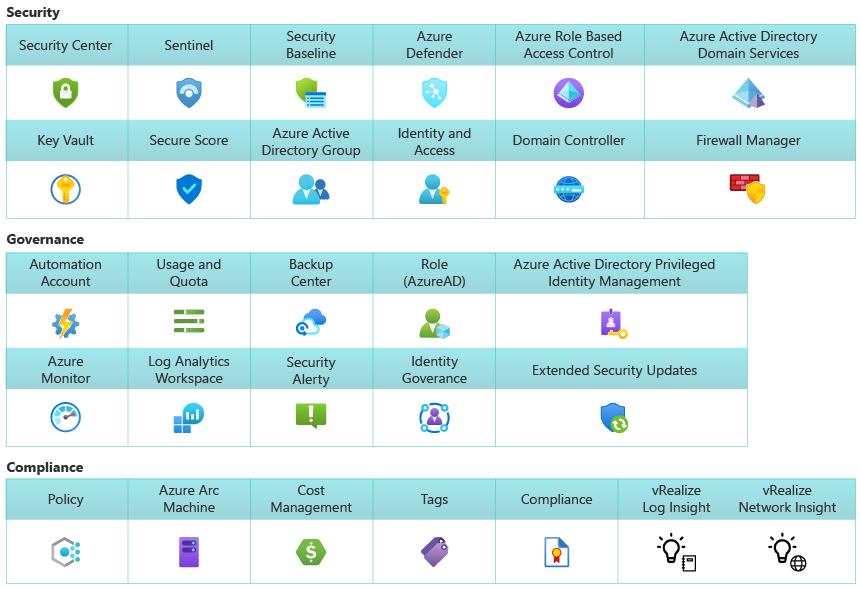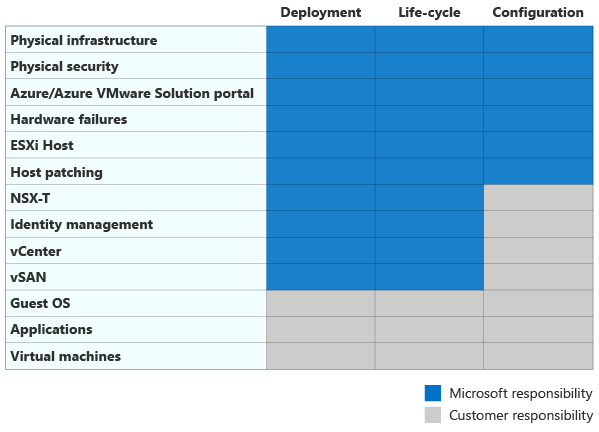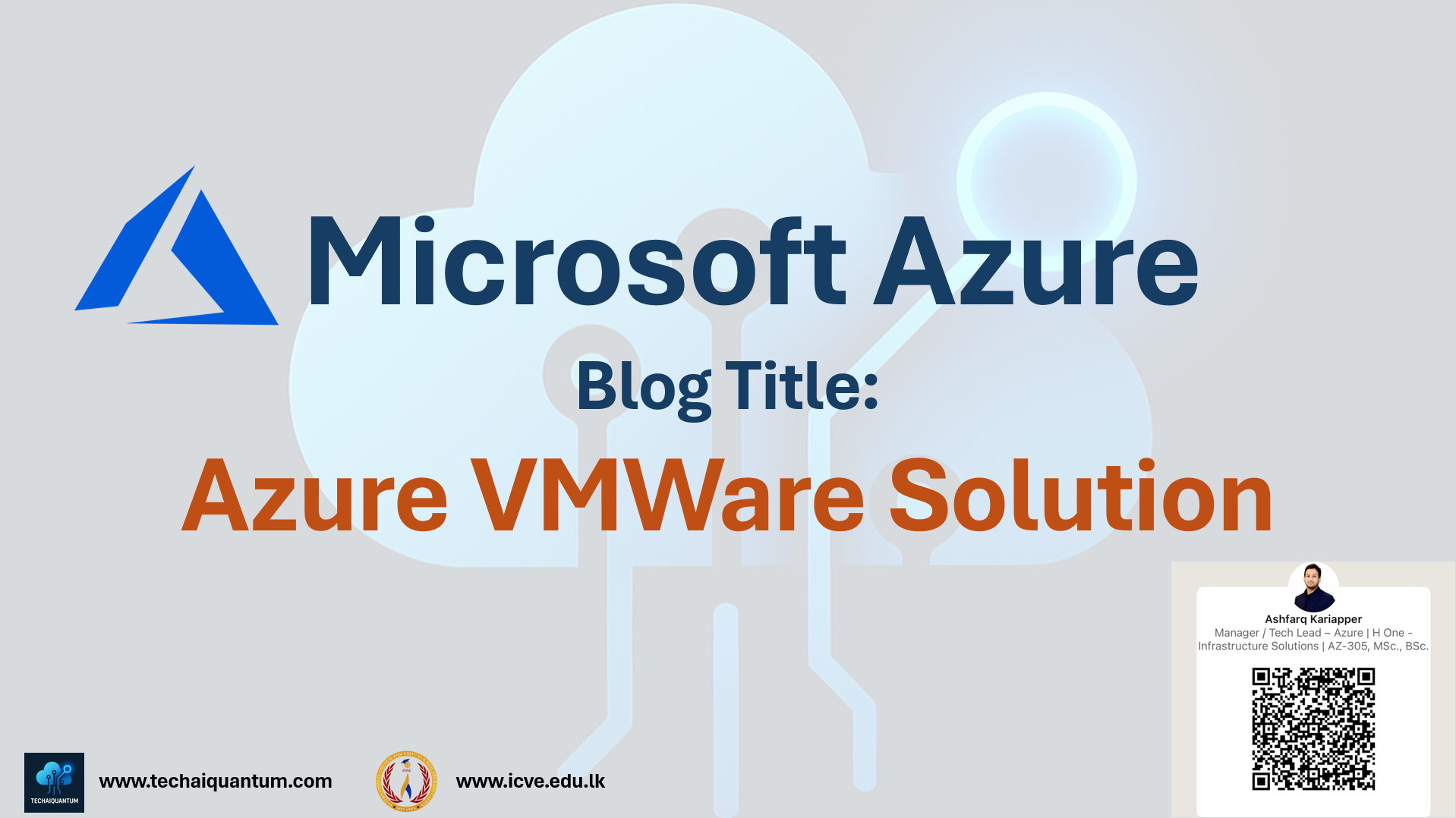Introduction
VMware is a leading technology company specializing in virtualization and cloud computing software. It enables multiple virtual computers, called virtual machines (VMs), to run on a single physical server by creating an abstraction layer between the hardware and the operating systems.
This virtualization allows more efficient use of hardware resources, scalability, and flexibility in deploying and managing applications.

What is VMWare?
Founded in 1998, VMware revolutionized IT infrastructure by providing tools that virtualize physical computers. This means that a single physical server can be partitioned into several virtual machines, each running its own operating system and applications independently. VMware's hypervisor software manages these VMs, allocating hardware resources such as CPU, memory, storage, and network bandwidth dynamically, while isolating them so that issues in one VM do not affect others.
Core VMWare Technology
- Hypervisor: VMware’s foundational technology is its hypervisor, a thin software layer installed directly on physical servers (bare metal). VMware ESXi is the flagship hypervisor, known for its small footprint, security, and high performance. It manages VMs by virtualizing hardware resources.
- Virtual Machines (VMs): Software-based emulations of physical machines that operate independently but share the underlying hardware
- vCenter Server: Centralized management platform for controlling multiple ESXi hosts and VMs, enabling resource allocation, monitoring, automation, and policy enforcement.
- vMotion: A key feature allowing live migration of running VMs between physical servers without downtime, supporting maintenance, load balancing, and fault tolerance.
- Clustering and High Availability: VMware provides clustering technologies such as High Availability (HA), Fault Tolerance (FT), and Distributed Resource Scheduler (DRS) to ensure continuous uptime, automatic failover, and optimized resource utilization across clusters of physical servers.

The Burden on VMWare
- High Licensing and Maintenance Costs: VMware licenses, especially for advanced features and large-scale deployments, are expensive. This can be a significant investment, particularly for small and medium-sized businesses, and ongoing maintenance and support costs add further financial burden.
- Resource Overhead and Performance Impact: Running multiple virtual machines on a physical server consumes resources, which can reduce performance if not managed correctly. Sharing hardware may introduce overhead, especially under peak loads or high I/O/computing demands.
- Hardware Dependency: VMware requires compatible and often high-spec hardware to perform well. Legacy or consumer-grade hardware may not be supported or may require costly upgrades to run VMware efficiently.
- Steep Learning Curve: VMware’s wide range of features and management tools demands specific skills and training. Organizations may need to invest time and resources to train IT staff, which can slow deployment and adoption.
- Compatibility Limitations: Some applications or legacy software might not fully support running inside VMware virtual environments, potentially causing issues with functionality or performance. VMware may also not support all operating systems and hardware configurations equally well, limiting flexibility in mixed environments.
- Management Restrictions in Free Versions: The free VMware ESXi version has limitations such as no official support, inability to manage with vCenter, and restricted CPU allocation for VMs, which can limit its use in production environments.
- Increased Complexity and Potential Failure Points: Introducing VMware adds complexity to the IT environment, adding more components to upgrade, troubleshoot, and secure. This can increase the attack surface and introduce additional potential failure points.
- Indirect burden: this refers to the hidden, non-direct costs involved in maintaining physical servers, such as expenses for cooling (air conditioning), security, power, facility upkeep, and environmental controls. These costs are not charged directly to servers but significantly add to the total cost of ownership (TCO). Often overlooked, they impact budgets and resource planning, making it important to consider them for a full picture of on-premises server expenses.

Challenges that revoke Platform Migrations
- Cloud platforms like Microsoft Azure, AWS, and Google Cloud offer on-demand scalability, allowing organizations to easily scale resources up or down based on workload fluctuations without the need for physical hardware changes. VMware on-premises environments are more limited in scalability since they require purchasing and configuring additional hardware.
- Cloud computing operates on a pay-as-you-go model, reducing upfront capital expenditures on hardware and shifting costs to operational expenses. While VMware requires substantial initial investment in servers and ongoing maintenance, cloud services reduce these barriers and provide cost control based on actual usage.
- Cloud providers handle infrastructure management, maintenance, updates, security patches, and disaster recovery, freeing internal IT teams to focus on strategic initiatives. In contrast, VMware on-premises environments require dedicated staff to manage hardware and virtualization software.
- Clouds provide easy access to a broad set of integrated services such as artificial intelligence, analytics, serverless computing, and global networking. This accelerates application modernization beyond what traditional VMware virtualization typically supports.
- Clouds provide easy access to a broad set of integrated services such as artificial intelligence, analytics, serverless computing, and global networking. This accelerates application modernization beyond what traditional VMware virtualization typically supports.
- While VMware provides robust security for virtualized data centers, some organizations prefer cloud providers’ advanced security features, especially for large-scale, distributed, or highly dynamic environments.
The Value of VMWare

- Control and Customization: Many enterprises prefer VMware for on-premises or private cloud environments because it offers complete control over hardware resources, security protocols, and system customization. This is important for workloads with strict performance, compliance, or legacy application requirements that public clouds may not fully address.
- Existing Investments and Skills: Organizations have invested heavily in VMware infrastructure and have established operational knowledge and processes around it. Moving away from VMware can mean costly retraining, migration efforts, and risk of downtime. Hybrid strategies often use VMware alongside public cloud rather than replacing it outright.
- Cost Considerations: For some workloads, using VMware on-premises can be more cost-effective than running equivalent workloads on public cloud, especially when factoring in ongoing cloud consumption costs. Private cloud VMware deployments also provide predictable pricing and efficient resource allocation.
- Performance and Latency: Applications requiring low latency or very high performance may benefit from on-premises VMware setups that avoid the unpredictable network latency of public clouds.
- Security and Isolation: VMware provides strong isolation between VMs, allowing multiple applications to coexist securely on shared hardware. It supports micro-segmentation, encryption, and compliance with stringent security policies, which is critical for regulated industries.
- Mature and Robust Virtualization Platform: VMware offers a highly reliable, feature-rich virtualization suite with capabilities like vMotion (live migration), high availability, fault tolerance, and centralized management with vCenter. These features ensure continuous uptime and smooth operations essential for enterprise workloads.
- Efficient Resource Utilization: VMware technology allows organizations to run multiple virtual machines (VMs) independently on a single physical server, making better use of CPU and other hardware resources. This reduces waste and improves operational efficiency, especially in environments with diverse application needs where isolation is critical.
The Rise of Azure VMWare Solution
Many times VMware vSphere environments on-premises have sprawled. Individual business units might have deployed many different workloads on servers that may not meet a standard baseline. If Azure VMware Solution becomes the first workload placed in Azure, IT engineers can make use of more Azure native resources to help streamline the operations baseline of vSphere VMs being migrated into Azure. Customers can onboard a combination of Azure Policy, Microsoft Defender for Cloud, Azure Monitor, and Azure Automation to ensure both state and infrastructure configuration remains consistent for each application or workload migrated into Azure VMware Solution

Now, Azure VMware Solution (AVS) is a fully managed service from Microsoft, validated by VMware, that enables organizations to run native VMware environments at scale on Microsoft Azure cloud infrastructure. It combines VMware's compute, storage, and networking technologies—vSphere, vCenter, vSAN, NSX, and HCX—deployed on dedicated bare-metal Azure hardware.
This unique blend empowers businesses to extend or migrate their on-premises VMware workloads to the cloud without the hassle of refactoring or replatforming.
Azure VMware Solution is a VMware-validated offering, undergoing continuous validation and testing of improvements and updates. Microsoft takes care of managing and maintaining the private cloud infrastructure and software, enabling you to concentrate on developing and operating workloads within your private clouds to drive business outcomes.
Azure VMware Solution lets you seamlessly migrate VMware workloads from your data center to Azure and integrate more Azure services with ease. You can manage your IT environments with the same VMware solution tools you already know at the same time. You have the choice and flexibility to determine what workloads to migrate, and you decide the right time to migrate them. With platform symmetry, you have complete control to transform based on how your organization defines its unique cloud journey.

Architecture of Extended VMWare Environment to AVS
On Azure, you can run, manage, and secure applications across VMware vSphere environments with a common operating framework. Use your existing VMware solution tools, like VMware vCenter Server, vSAN, and NSX-T Manager, combined with the scale, performance, and innovation of Azure. In terms of access and security, Azure VMware Solution private clouds use vSphere role-based access control for enhanced security. You can integrate vSphere SSO LDAP capabilities with Microsoft Entra ID.
Integrating with Azure-native services in your Azure VMware Solution private cloud will ensure that your Azure VMware Solution workloads benefit from unified operations best practices for governance guardrails.
- Unified VM management: Single pane of glass to manage vSphere-based and Azure native VMs, with uniform identities, access control, and monitoring.
- Native Azure integration: Connect to Azure services endpoints. For example, deploy Microsoft Entra ID as VMware vCenter Server SSO identity source.
- Single point of support: Azure VMware Solution is Microsoft-developed, operated, and supported. Microsoft is the first and only contact and coordinates support with VMware as required.
- Unified licensing and consumption: Avoid unnecessary complexity and take confidence in managing a single vendor for licensing and resource consumption.
- Azure Hybrid Use Benefits: Maximize the value of existing Windows Server and SQL Server licenses. Save up to 80 percent with Azure hybrid use benefits and Azure Reserved VM Instances.

Govern the Azure VMWare Solution
Azure VMware Solution brings together VMware's Software-Defined Data Center (SDDC) technologies with Azure’s extensive global cloud platform. Microsoft takes care of managing Azure VMware Solution to ensure it meets key standards for performance, availability, security, and compliance. Microsoft provides all the essential components needed to run Azure VMware Solution smoothly at scale, including management systems, networking services, the operating platform, and backend infrastructure.
To broaden the customer's organization governance approach for Azure VMware Solution; I propose to start by identifying high-risk areas within their business and define their risk tolerance. Then translate these risks into corporate governance policies. Apply these policies across key areas such as Cost Management, Security Baseline, Identity Baseline, Resource Consistency, and Deployment Acceleration to maintain comprehensive control over your cloud portfolio.
These governance services can be attained through Microsoft Azure Services

Azure VMware Solution is an Azure service built with VMware products that delivers vSphere clusters, in a single-tenant private cloud environment. It's accessible for users and applications from on-premises vSphere solutions and Azure-based environments or resources. The VMware technology stack in Azure Cloud runs with a highly secure set of compute, storage, and networking technologies.
All provisioned private clouds have vCenter Server, ESXi, vSAN, and NSX-T Data Center, so you can migrate workloads from your on-premises vSphere environments, deploy new virtual machines (VMs), and consume Azure services from your private clouds.
VMware vSphere clusters reside on top of "share nothing" hyper-converged, bare-metal infrastructure. Azure VMware Solution cluster architecture is dedicated and isolated - meaning that networking, storage, or compute is not shared with any other tenant. VMware vSphere clusters are managed by Microsoft to meet performance, availability, security, and compliance requirements, at scale in Azure Cloud, providing unified management, networking, and operational controls.
Because Azure VMware Solution run hybrid workloads across on-premises vSphere and private cloud, unified operations is the best approach to providing a single pane of glass for incrementally deploying required governance and operational management controls.
On Azure, you can run, manage, and secure applications across VMware vSphere environments with a common operating framework. Use your existing VMware solution tools, like VMware vCenter Server, vSAN, and NSX-T Manager, combined with the scale, performance, and innovation of Azure. In terms of access and security, Azure VMware Solution private clouds use vSphere role-based access control for enhanced security. You can integrate vSphere SSO LDAP capabilities with Microsoft Entra ID.
Azure VMWare Solution - Roles and Responsibilities (RnR)
The Manage methodology in the Microsoft Cloud Adoption Framework for Azure provides a structured approach to establishing an operational baseline and evolving it throughout your cloud adoption journey.
Azure VMware Solution is a validated VMware offering that undergoes continual verification and testing to incorporate VMware product updates and enhancements. Microsoft handles the management and maintenance of the private cloud infrastructure and software on your behalf. By shifting this responsibility to Microsoft, you can concentrate on developing and running workloads within your private cloud as well as leveraging Azure native resources. Frequent upgrades to both the Azure VMware Solution private cloud and VMware software ensure your deployed environment remains current with the latest security, stability, and feature improvements.
Microsoft consistently shares a shared responsibility matrix for various service models including infrastructure as a service (IaaS), platform as a service (PaaS), and software as a service (SaaS).

A similar matrix exists for Azure VMware Solution, which highlights that Microsoft takes on much of the ongoing maintenance, security, and management duties. This enables your organization to focus on critical areas such as provisioning guest operating systems, managing applications, and handling virtual machines. Additionally, this approach allows you to apply your own lifecycle management and configuration practices within the Azure environment. As a result, certain operational tasks are alleviated, with Microsoft assuming greater responsibility for the underlying Azure VMware Solution infrastructure.

With Azure VMware Solution, Microsoft takes care of the underlying infrastructure once the solution is deployed in Azure. This means IT teams don’t have direct access to perform certain tasks—like getting root access to the individual ESXi hosts or joining the vCenter Server to a domain—unless they submit a support ticket. This setup is a bit different from traditional IT operations, where central IT staff have full control over the on-premises VMware vSphere environment.
By operating VMware vSphere this way, IT operations engineers can spend less time managing infrastructure and more time focusing on innovating the applications and workloads that drive the business forward. It also supports a broader digital transformation that goes beyond just the Azure VMware Solution itself.
Azure VMWare Solution - Motivates to consider AVS
Organizations choose Azure VMware Solution for a variety of reasons tied to business, IT, operational, and strategic needs.
- Business needs focus on accelerating migration of VMware workloads and quickly scaling capacity while reducing costs, complexity, and risks tied to big migration projects.
- IT needs include ensuring business continuity, deploying disaster recovery, and scaling on-premises VMware environments with minimal changes to applications—including VDI setups that don't require modernization. Azure VMware Solution also allows retention of original IP and MAC addresses after migration, which helps avoid application issues and licensing compliance problems. IT teams can continue using their current functional testing tools and processes.
- Operational needs highlight the value of leveraging existing VMware skills, licenses (such as VMware SRM and NSX Advanced Load Balancer), and IT processes, while enabling the team to build cloud skills over time. The solution also reduces configuration changes at the VM level after migration, lessening testing efforts, and allows reuse of existing disaster recovery sites and tools.
- Strategic needs center on the ability to modernize VMware-based applications gradually using Azure services as business needs evolve. Additionally, the shift helps mitigate risks associated with unpredictable hardware supply chain issues impacting on-premises data centers.
In essence, Azure VMware Solution offers a seamless, low-risk path to cloud migration that preserves operational consistency and maximizes existing investments while supporting growth and innovation.
Azure VMWare Solution - Outcome of AVS
Azure VMware Solution delivers key outcomes that help organizations migrate faster, reduce costs, and improve reliability while modernizing their VMware workloads in the cloud.
Accelerate Migration and Lower Costs
- Simplify and speed up migration of VMware vSphere workloads to Azure with minimal downtime using live bulk VM migration and HCX Enterprise capabilities.
- Keep using your familiar VMware tools and processes without retraining staff or changing your ESXi hypervisor.
- Maintain operational consistency with direct access to vSphere interfaces and seamless workload mobility that preserves IP addresses.
- Reduce change management impacts and develop Azure cloud skills incrementally as your team grows more comfortable.
Gain Reliability and Scalability
- Benefit from Azure’s global infrastructure for continuity, scale, and automated provisioning of VMware environments.
- Add or remove compute and storage resources elastically as needed. Ensure business continuity with built-in high availability, disaster recovery, and backup options.
- Connect securely and quickly to both Azure and on-premises data centers via ExpressRoute.
- Run workloads on robust, dedicated bare-metal infrastructure optimized for demanding VMware workloads.
Optimize Licensing Costs
- Save with free extended security updates for Windows Server 2012 and SQL Server 2012 when transitioning to Azure.
- Use Azure Hybrid Benefit to bring existing Windows and SQL Server licenses to Azure, reducing costs.
- Save 30-50% with Azure Reservations for 1- and 3-year reserved instances on dedicated hosts, with no cancellation fees.
Modernize Applications over Time
- Integrate VMware workloads with Azure native management, security, and services for gradual modernization.
- Use Azure Arc to unify management across VMware, Azure, and other hybrid environments.
- Connect VMware workloads to Azure services like Microsoft Entra ID, SQL Managed Instance, and analytics.
- Apply native Azure monitoring and security solutions like Azure Monitor and Microsoft Defender for Cloud. Achieve seamless identity and access management with Microsoft Entra ID single sign-on (SSO) for VMware vCenter.
Why Azure VMware Solution is a Game-Changer for Your Cloud Journey
Perhaps best of all, Azure VMware Solution gives you a clear path to modernize your applications, integrating seamlessly with Azure-native services when you’re ready. It’s a future-proof solution that balances preserving your current environment with embracing new cloud opportunities.
In short, I believe, if your business is looking to confidently step into the cloud while protecting existing VMware investments Azure VMware Solution is an excellent choice that unlocks agility, efficiency, and innovation across your cloud journey.
I have added a video for an easy understanding on how AVS works in High Level


